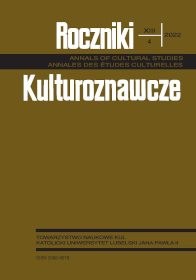TO ART, OR NOT TO ART, THAT IS THE QUESTION
TO ART, OR NOT TO ART, THAT IS THE QUESTION
Author(s): TYRONE GRIMASubject(s): Sociology of Culture, Cultural Essay, Sociology of Art, History of Art
Published by: Towarzystwo Naukowe KUL & Katolicki Uniwersytet Lubelski Jana Pawła II
Keywords: art; recipient; creator;
Summary/Abstract: he Herculean task of defining art across the centuries has been a preoccupation that can be compared to Sisyphus’ rolling of the boulder up the hill. The climax is reached, and for a span of time, the task is achieved: the definition has been finally captured. Yet this phase is short lived: the semantics reveal to be insufficient; the deficiencies emerge in full throttle; and the illusion shatters. The boulder rolls back down, and the process recommences once again, possibly in vain. This short reflection will not attempt to enlist and analyse the attempts of the various theorists who have sought to provide a conceptual framework on the subject, no matter how useful they may be. Heavily influenced by apophatic thought, this contribution will proceed by providing a ‘definition’ (for lack of a better word), through the process of negation. In brief, art cannot be defined. It can only be experienced, and linguistic tools cannot do justice to such an experience. Nonetheless, this reflection will make use of select thoughts taken from the apophatic spirituality of the French philosopher, Simone Weil (1909– 1943) on art to grabble with some provocations that this mystic offers and which can empower the artist to discern whether the work that he2 is engaged in is truly artistic. Extra-ordinary communication, Habermas analyzes in Nachmetaphysisches Denken II, is represented by religious rituals that reveal the human fundamental relationship with the divine. The anthropological research of Ernesto De Martino showed that the experience of precariousness of human life has a cognitive value as a source of reassuring models constituted in the tradition. The sociologist Emile Durkheim and the anthropologist Bronislaw Malinowski pointed on the function of rituals for the cohesion of communities. The antropologists Arnold van Gennep and Meyer Fortes considered the social and cultural role of the myth that extends to the religious sphere. The ongoing philosophical discussion on the nature and function of rituals presents several fundamental perspectives. Art is a fundamental dimension that seems to belong to the very nature of rituals.
Journal: Roczniki Kulturoznawcze
- Issue Year: 13/2022
- Issue No: 4
- Page Range: 87-91
- Page Count: 5
- Language: English

